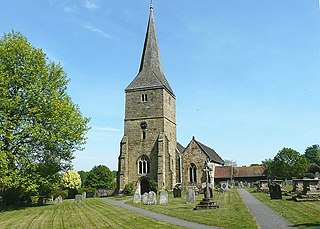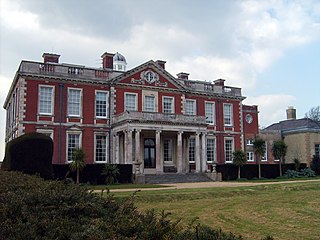
Anne Boleyn was Queen of England from 1533 to 1536, as the second wife of King Henry VIII. The circumstances of her marriage and of her execution by beheading for treason and other charges made her a key figure in the political and religious upheaval that marked the start of the English Reformation. Anne was the daughter of Thomas Boleyn, 1st Earl of Wiltshire, and his wife, Lady Elizabeth Howard, and was educated in the Netherlands and France, largely as a maid of honour to Queen Claude of France. Anne returned to England in early 1522, to marry her Irish cousin James Butler, 9th Earl of Ormond; the marriage plans were broken off, and instead she secured a post at court as maid of honour to Henry VIII's wife, Catherine of Aragon.

Oxfordshire is a landlocked county in the far west of the government statistical region of South East England. The ceremonial county borders Warwickshire to the north-west, Northamptonshire to the north-east, Buckinghamshire to the east, Berkshire to the south, Wiltshire to the south-west and Gloucestershire to the west.

Hever Castle is located in the village of Hever, Kent, near Edenbridge, 30 miles (48 km) south-east of London, England. It began as a country house, built in the 13th century. From 1462 to 1539, it was the seat of the Boleyn family.

Penshurst Place is a historic building near Tonbridge, Kent, 32 miles (51 km) south east of London, England. It is the ancestral home of the Sidney family, and was the birthplace of the great Elizabethan poet, courtier and soldier, Sir Philip Sidney. The original medieval house is one of the most complete surviving examples of 14th-century domestic architecture in England. Part of the house and its gardens are open for public viewing. Many TV shows and movies have been filmed at Penshurst.

Hartfield is a village and civil parish in the Wealden district of East Sussex, England. The parish also includes the settlements of Colemans Hatch, Hammerwood and Holtye, all lying on the northern edge of Ashdown Forest.

Odiham is a large historic village and civil parish in the Hart district of Hampshire, England. It is twinned with Sourdeval in the Manche Department of France. The 2011 population was 4,406. The parish in 1851 had an area of 7,354 acres with 50 acres covered by water. The nearest railway station is at Hook, on the South West main line. The village had its own hundred in the nineteenth century, named The Hundred of Odiham. The village is situated slightly south of the M3 motorway and approximately midway between the north Hampshire towns of Fleet and Basingstoke, some 37 miles north-northeast of Southampton and 43 miles (69 km) southwest of London.

Thornbury Castle is a Tudor castle in the parish of Thornbury, in Gloucestershire, England, situated next to the parish church of St Mary, founded in the Norman era. Construction was begun in 1511 as a further residence for Edward Stafford, 3rd Duke of Buckingham (1478-1521), of Stafford Castle in Staffordshire. It is not a true military fortress but rather an early example of a Tudor country house, with minimal defensive attributes. As at Richmond Palace in Surrey, the main ranges of Thornbury framed courts, of which the symmetrical entrance range, with central gatehouse and octagonal corner towers, survives, together with two less regular side ranges with many irregular projecting features and towers. It is now a grade I listed building that is operated as a hotel.

West Wickham is a suburban area of Greater London, England, within the London Borough of Bromley. It lies south of Park Langley and Eden Park, west of Hayes and Coney Hall, north of Spring Park and east of Shirley, 10.3 miles (16.6 km) south-east of Charing Cross on the line of a Roman road, the London to Lewes Way. Before the creation of Greater London in 1965, West Wickham was in Kent.

Upton Park is an area of the East London borough of Newham, centred on Green Street which is the boundary between West Ham and East Ham. West Ham United Football Club formerly played at the Boleyn Ground, commonly known as Upton Park.

Toddington is a large village and civil parish in the county of Bedfordshire, England. It is situated 5 miles north-north-west of Luton, 4 miles (6 km) north of Dunstable, 6 miles (10 km) south-west of Woburn, and 35 miles north-north-west of London on the B5120 and B579. It is 0.5 miles from Junction 12 of the M1 motorway and lends its name to the nearby motorway service station. The hamlet of Fancott also forms part of the Toddington civil parish.

East Ham is a constituency in the London Borough of Newham represented in the House of Commons of the UK Parliament since its creation in 1997 by Stephen Timms of the Labour Party.

East Barsham Manor is an important work of Tudor architecture, a leading and early example of a prodigy house, originally built in the 1520s. It is located in the village of East Barsham, about 2.5 miles (4.1 km) north of the town of Fakenham and 2.1 miles (3.4 km) south west of the village of Walsingham in the English county of Norfolk. It is protected as a Grade I listed building.

Stansted Park is an Edwardian country house in the parish of Stoughton, West Sussex, England. It is near the city of Chichester, and also the village of Rowlands Castle to the west over the border in Hampshire.

Lullingstone Castle is a historic manor house, set in an estate in the village of Lullingstone and the civil parish of Eynsford in the English county of Kent. It has been inhabited by members of the Hart Dyke family for twenty generations including current owner Tom Hart Dyke.

Pishiobury, sometimes spelled Pishobury, was a manor and estate in medieval Sawbridgeworth, Hertfordshire. Its denomination as "Pishiobury" only emerged in the mid to late 19th century.

Rochford Hall is a manor in Rochford, Essex, England. During the reign of King Henry VIII, it belonged to Thomas Boleyn, who was then Viscount Rochford, and it was the marital home of his daughter Mary Boleyn, sister of Anne Boleyn, and Mary's second husband, Sir William Stafford. It is now privately owned by Rochford Hundred Golf Club where it acts as the clubhouse and is a Grade I listed building.

Stone Castle is a castle at Stone, near Bluewater in Kent, England. It was built between 1135 and 1140 on the site where William the Conqueror signed a treaty with the men of Kent in 1067.
The More was a 16th-century palace in the parish of Rickmansworth, Hertfordshire, England, where Catherine of Aragon lived after the annulment of her marriage to Henry VIII. It had been owned by Cardinal Wolsey. It lay at the northeast corner of the later More Park estate on the edge of the Colne flood plain. The Treaty of the More was celebrated here by Henry VIII and the French ambassadors. In 1527, the French ambassador, Jean du Bellay, thought the house more splendid than Hampton Court. Nothing now remains above ground. The site is a scheduled ancient monument. In the grounds of the school exist parts of at least two large stone pillars approximately one metre in length which are said to be part of the original manor.
The Bolebroke Castle Miniature Railway or Bolebroke Castle and Lakes Railway was a 7+1⁄4 inches (180 mm) railway that ran within the grounds of Bolebroke Castle. The railway was approximately 2+1⁄2 miles (4.0 km) in length, however, only parts of the railway were open freely to the public. The railway closed in 2012 after the owner's passing, and the stock/track was distributed to volunteers and new owners.
Green Street House, usually known as Boleyn Castle, was a stately home in East Ham in the modern London Borough of Newham, East London.

















